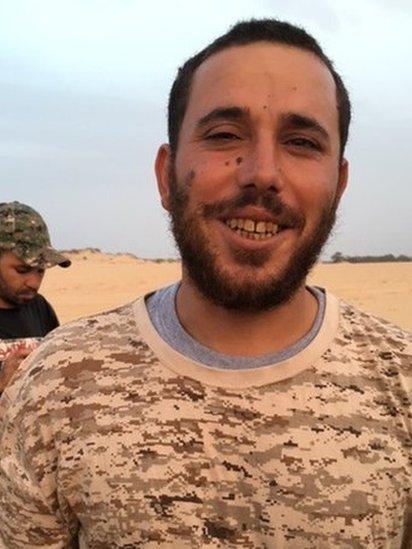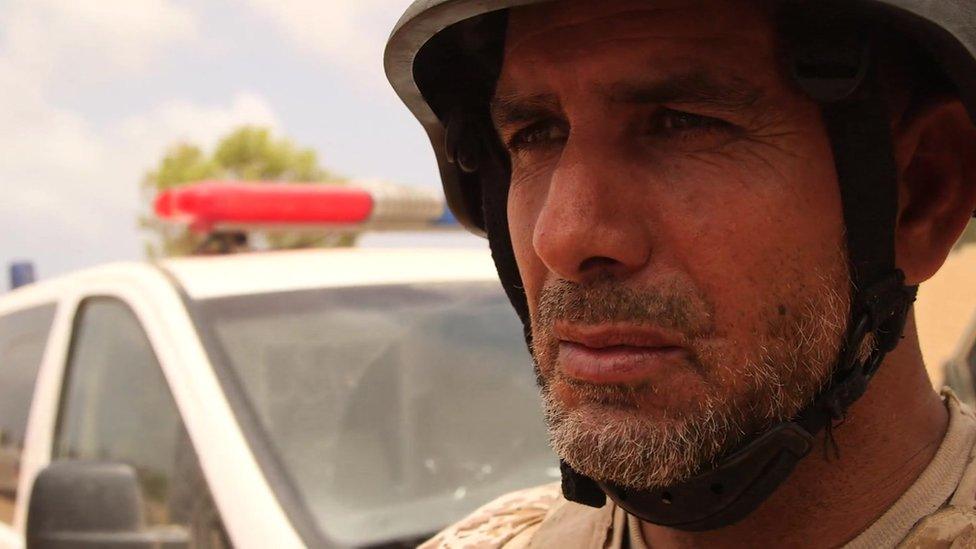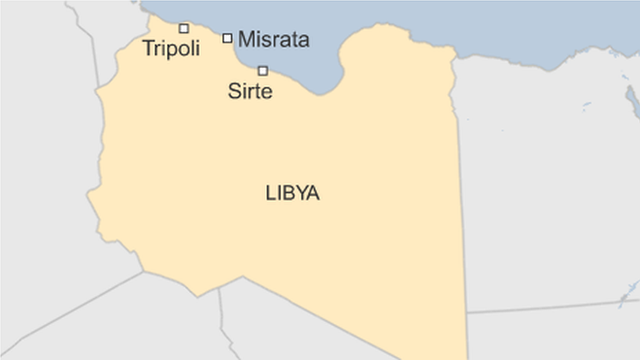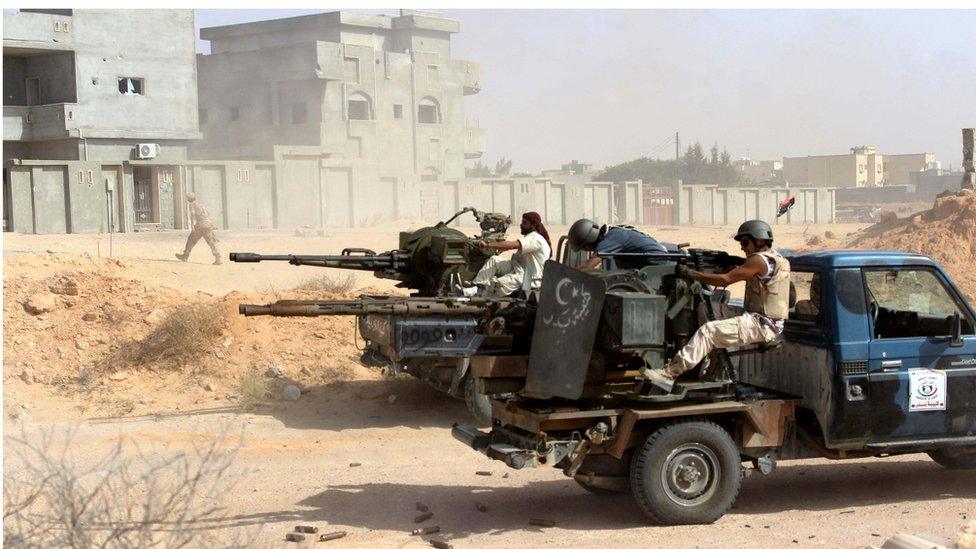Islamic State conflict: The Libyans gaining ground in Sirte
- Published
The Libyans fighting IS in Sirte
From the sand dunes of eastern Sirte, the so-called Islamic State's port is clearly visible. Fishing boats are docked on the quayside, out of the water. Over the horizon is Europe. At the port, nothing stirs.
But put your head above the dunes here and you risk getting shot.
IS group snipers have occupied a Gaddafi-era hotel on the coast.
Yet in the city behind them, one they have controlled since early last year, their territory diminishes week after week.
IS can no longer get larger boats in and out of the harbour. Sirte was to be the Islamic State's bolt-hole from its bases in Iraq and Syria. But here, as in their home territories, the militants are losing.
Libya's pro-government forces are gaining ground.

Hamza Hassan leads a brigade and has lost his own father in the fighting
Keeping watch here is Hamza Hassan of Brigade 166 from the nearby city of Misrata. His brigade are weary from fasting for Ramadan and they have lost nine men so far in the fight for Sirte.
Among their losses was Mr Hassan's father.
But the brigade's job is to pin IS down and stop them escaping by sea. And Brigade 166 is making progress.
Mr Hassan says: "The only problem we're facing is suicide car bombs. We're taking out their tyres, firing heavy weapons at them and closing roads."
The city is seeing battle. I watched from a rooftop as northern Sirte came alive with tracer rounds and mortars. Rounds bounced off buildings and fell deep into the densely packed streets of the city.

Mahamud Madi, Bin Mousa brigade:

"They [IS] beheaded our children, crucified them, threw them off the roofs of buildings, terrorised the people and abused faith to justify their crimes"

A young and improvised force
Mr Hassan is a veteran of the civil war but he says this fight is different.
"The guerrilla warfare is similar to 2011 but these are a different breed of people," he says.

Many of those fighting IS are from Misrata, which lies between Sirte and the capital, Tripoli
"Then, there was no-one willing to carry a suicide attack against you. Now, we don't know how to deal with their fighters surrendering to us. They put their hands in the air so you think they're surrendering and then detonate themselves".

Life under Islamic State
February: IS morality police enforce the group's strict interpretation of Islamic rules, including public floggings. Social media pictures show "crucified" corpses on a street after killings by IS
March: IS wants to show that life goes on as normal, posting images of public services department workers pruning trees, sheep-grazing, bee-keepers at work and a car showroom
April: Militants publicise the religious education of residents with pictures of a graduation ceremony for hundreds of ordinary people
May: A government-led advance recovers towns from IS to the east, west and south before entering Sirte

I spent three days with his men then headed south of the city for an offensive to clear the neighbourhood of snipers, which had the effect of joining Libyan forces in the west of the city to Mr Hassan's men in the east.
Hundreds of men lined up on the back of Libyan "technicals", pick-up trucks equipped with large guns. A few tanks joined the front.

The anti-IS forces have gained ground recently
There was little in the way of air support, but a drone buzzed high in the sky.
For the past two weeks it had been mapping the buildings used by snipers, and with co-ordination from UK and US special forces, the men at the front were now hitting those buildings with everything they had.
The noise was deafening and huge clouds of dust and debris were thrown into the air. It didn't take long for IS to respond with mortars of their own and deadly sniper fire.
It was a costly day for Libyan fighters. They are mostly militia with some army, and all under the authority of Libya's UN-backed Tripoli-based government. Although like Mr Hassan many are veterans of the 2011 war, this is a young and improvised force.

Many of the pro-government forces are young men, without much training
They have almost no body armour or helmets, and their weapons are outdated.
At the edge of the battlefield, one curly-haired fighter, perhaps still in his teens, joked as I took a photograph.
"Take my picture," he said, "because I'm going to die today". His comrades laughed and told him to be quiet.
At a nearby field hospital, casualties soon began arriving.
Half a dozen ambulances stood at the hospital entrance with their doors open.
The injured, more than 150, were strangely quiet.
There was little crying out in pain, but occasionally a call of "Allahu Akhbar" would go up as the corpse of a dead fighter arrived.
Some were transferred straight from the ambulances to body bags in a shaded area outside the hospital.
Almost 50 were killed in the first round of fighting.
'Sacrifice worth paying'
Mahamud Madi of the Bin Mousa brigade brought in one of his fighters, wrapped in a brightly coloured blanket.
He didn't make it but another fighter, who had been shot in the neck by an IS sniper, survived.
Mr Madi's trousers were soaked in their blood, his boots splattered.
But to him, this was a sacrifice worth paying if it meant defeating IS.
"They beheaded our children, crucified them, threw them off the roofs of buildings, terrorised the people and abused faith to justify their crimes," he said.
"Islamic faith has no room for them. They are outsiders and it is permitted to kill them and treat them with no mercy."
The toughest fighting still lies ahead, but the Libyan forces are pressing ahead. It will likely be weeks if not months before Sirte is once again liberated.
IS threatened to send their jihadists to the gates of Rome.
In Sirte, they will be lucky to survive much beyond the end of Ramadan in a couple of weeks' time.